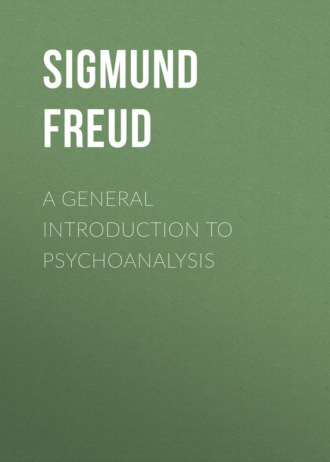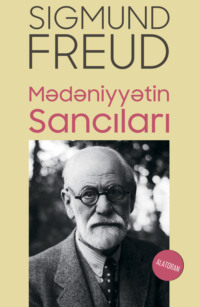 полная версия
полная версияA General Introduction to Psychoanalysis
In the representation of parts of speech that denote thought relations, such as because, therefore, but, etc., you have no such aids; these constituent parts of the text will therefore be lost in your translation into images. In the same way, the dream-work resolves the content of the dream thought into its raw material of objects and activities. You may be satisfied if the possibility is vouchsafed you to suggest certain relations, not representable in themselves, in a more detailed elaboration of the image. In quite the same way the dream-work succeeds in expressing much of the content of the latent dream thought in the formal peculiarities of the manifest dream, in its clearness or vagueness, in its division into several parts, etc. The number of fragmentary dreams into which the dream is divided corresponds as a rule to the number of main themes, of thought sequences in the latent dream; a short preliminary dream often stands as an introduction or a motivation to the complementary dream which follows; a subordinate clause in dream thought is represented in the manifest dream as an interpolated change of scene, etc. The form of the dream is itself, therefore, by no means without significance and challenges interpretation. Different dreams of the same night often have the same meaning, and testify to an increasing effort to control a stimulus of growing urgency. In a single dream a particularly troublesome element may be represented by "duplicates," that is, by numerous symbols.
By continually comparing dream thought with the manifest dream that replaces it, we learn all sorts of things for which we were not prepared, as for instance, the fact that even the nonsense and absurdity of the dream have meaning. Yes, on this point the opposition between the medical and psychoanalytic conception of the dream reaches a climax not previously achieved. According to the former, the dream is senseless because the dreaming psychic activity has lost all power of critical judgment; according to our theory, on the other hand, the dream becomes senseless, whenever a critical judgment, contained in the dream thought, wishes to express the opinion: "It is nonsense." The dream which you all know, about the visit to the theatre (three tickets 1 Fl. 50 Kr.) is a good example of this. The opinion expressed here is: "It was nonsense to marry so early."
In the same way, we discover in interpretation what is the significance of the doubts and uncertainties so often expressed by the dreamer as to whether a certain element really occurred in the dream; whether it was this or something else. As a rule these doubts and uncertainties correspond to nothing in the latent dream thought; they are occasioned throughout by the working of the dream censor and are equivalent to an unsuccessful attempt at suppression.
One of the most surprising discoveries is the manner in which the dream-work deals with those things which are opposed to one another in the latent dream. We already know that agreements in the latent material are expressed in the manifest dream by condensations. Now oppositions are treated in exactly the same way as agreements and are, with special preference, expressed by the same manifest element. An element in a manifest dream, capable of having an opposite, may therefore represent itself as well as its opposite, or may do both simultaneously; only the context can determine which translation is to be chosen. It must follow from this that the particle "no" cannot be represented in the dream, at least not unambiguously.
The development of languages furnishes us with a welcome analogy for this surprising behavior on the part of the dream work. Many scholars who do research work in languages have maintained that in the oldest languages opposites – such as strong, weak; light, dark; big, little – were expressed by the same root word. (The Contradictory Sense of Primitive Words.) In old Egyptian, ken originally meant both strong and weak. In conversation, misunderstanding in the use of such ambiguous words was avoided by the tone of voice and by accompanying gestures, in writing by the addition of so-called determinatives, that is, by a picture that was itself not meant to be expressed. Accordingly, if ken meant strong, the picture of an erect little man was placed after the alphabetical signs, if ken, weak, was meant, the picture of a cowering man followed. Only later, by slight modifications of the original word, were two designations developed for the opposites which it denoted. In this way, from ken meaning both strong and weak, there was derived a ken, strong, and a ken, weak. It is said that not only the most primitive languages in their last developmental stage, but also the more recent ones, even the living tongues of to-day have retained abundant remains of this primitive opposite meaning. Let me give you a few illustrations of this taken from C. Abel (1884).
In Latin there are still such words of double meaning:
altus– high, deep, and sacer, sacred, accursed.
As examples of modifications of the same root, I cite:
clamare– to scream, clam– quiet, still, secret;
siccus– dry, succus– juice.
And from the German:
Stimme– voice, stumm– dumb.
The comparison of related tongues yields a wealth of examples:
English: lock; German: Loch– hole, Lücke– gap.
English: cleave; German: kleben– to stick, to adhere.
The English without, is to-day used to mean "not with"; that "with" had the connotation of deprivation as well as that of apportioning, is apparent from the compounds: withdraw, withhold. The German wieder, again, closely resembles this.
Another peculiarity of dream-work finds it prototype in the development of language. It occurred in ancient Egyptian as well as in other later languages that the sequence of sounds of the words was transposed to denote the same fundamental idea. The following are examples from English and German:
Topf—pot; boat—tub; hurry—Ruhe (rest, quiet).
Balken (beam) —Kloben (mallet) —club.
From the Latin and the German:
capere (to seize) —packen (to seize, to grasp).
Inversions such as occur here in the single word are effected in a very different way by the dream-work. We already know the inversion of the sense, substitution by the opposite. Besides there are inversions of situations, of relations between two people, and so in dreams we are in a sort of topsy-turvy world. In a dream it is frequently the rabbit that shoots the hunter. Further inversion occurs in the sequence of events, so that in the dream the cause is placed after the effect. It is like a performance in a third-rate theatre, where the hero falls before the shot which kills him is fired from the wings. Or there are dreams in which the whole sequence of the elements is inverted, so that in the interpretation one must take the last first, and the first last, in order to obtain a meaning. You will recall from our study of dream symbolism that to go or fall into the water means the same as to come out of it, namely, to give birth to, or to be born, and that mounting stairs or a ladder means the same as going down. The advantage that dream distortions may gain from such freedom of representation, is unmistakable.
These features of the dream-work may be called archaic. They are connected with ancient systems of expression, ancient languages and literatures, and involve the same difficulties which we shall deal with later in a critical connection.
Now for some other aspects of the matter. In the dream-work it is plainly a question of translating the latent thoughts, expressed in words, into psychic images, in the main, of a visual kind. Now our thoughts were developed from such psychic images; their first material and the steps which led up to them were psychic impressions, or to be more exact, the memory images of these psychic impressions. Only later were words attached to these and then combined into thoughts. The dream-work therefore puts the thoughts through a regressive treatment, that is, one that retraces the steps in their development. In this regression, all that has been added to the thoughts as a new contribution in the course of the development of the memory pictures must fall away.
This, then, is the dream-work. In view of the processes that we have discovered about it, our interest in the manifest dream was forced into the background. I shall, however, devote a few remarks to the latter, since it is after all the only thing that is positively known to us.
It is natural that the manifest dream should lose its importance for us. It must be a matter of indifference to us whether it is well composed or resolved into a series of disconnected single images. Even when its exterior seems to be significant, we know that it has been developed by means of dream distortion and may have as little organic connection with the inner content of the dream as the facade of an Italian church has with its structure and ground plan. At other times this facade of the dream, too, has its significance, in that it reproduces with little or no distortion an important part of the latent dream thought. But we cannot know this before we have put the dream through a process of interpretation and reached a decision as to what amount of distortion has taken place. A similar doubt prevails when two elements in the dream seem to have been brought into close relations to one another. This may be a valuable hint, suggesting that we may join together those manifest thoughts which correspond to the elements in the latent dream; yet at other times we are convinced that what belongs together in thought has been torn apart in the dream.
As a general rule we must refrain from trying to explain one part of the manifest dream by another, as if the dream were coherently conceived and pragmatically represented. At the most it is comparable to a Breccian stone, produced by the fusion of various minerals in such a way that the markings it shows are entirely different from those of the original mineral constituents. There is actually a part of the dream-work, the so-called secondary treatment, whose function it is to develop something unified, something approximately coherent from the final products of the dream-work. In so doing the material is often arranged in an entirely misleading sense and insertions are made wherever it seems necessary.
On the other hand, we must not over-estimate the dream-work, nor attribute too much to it. The processes which we have enumerated tell the full tale of its functioning; beyond condensing, displacing, representing plastically, and then subjecting the whole to a secondary treatment, it can do nothing. Whatever of judgment, of criticism, of surprise, and of deduction are to be found in the dream are not products of the dream-work and are only very seldom signs of afterthoughts about the dream, but are generally parts of the latent dream thought, which have passed over into the manifest dream, more or less modified and adapted to the context. In the matter of composing speeches, the dream-work can also do nothing. Except for a few examples, the speeches in the dream are imitations and combinations of speeches heard or made by oneself during the day, and which have been introduced into the latent thought, either as material or as stimuli for the dream. Neither can the dream pose problems; when these are found in the dream, they are in the main combinations of numbers, semblances of examples that are quite absurd or merely copies of problems in the latent dream thought. Under these conditions it is not surprising that the interest which has attached itself to the dream-work is soon deflected from it to the latent dream thoughts which are revealed in more or less distorted form in the manifest dream. It is not justifiable, however, to have this change go so far that in a theoretical consideration one regularly substitutes the latent dream thought for the dream itself, and maintains of the latter what can hold only for the former. It is odd that the results of psychoanalysis should be misused for such an exchange. "Dream" can mean nothing but the result of the dream-work, that is, the form into which the latent dream thoughts have been translated by the dream-work.
Dream-work is a process of a very peculiar sort, the like of which has hitherto not been discovered in psychic life. These condensations, displacements, regressive translations of thoughts into pictures, are new discoveries which richly repay our efforts in the field of psychoanalysis. You will realize from the parallel to the dream-work, what connections psychoanalytic studies will reveal with other fields, especially with the development of speech and thought. You can only surmise the further significance of these connections when you hear that the mechanism of the dream structure is the model for the origin of neurotic symptoms.
I know too that we cannot as yet estimate the entire contribution that this work has made to psychology. We shall only indicate the new proofs that have been given of the existence of unconscious psychic acts – for such are the latent dream thoughts – and the unexpectedly wide approach to the understanding of the unconscious psychic life that dream interpretation opens up to us.
The time has probably come, however, to illustrate separately, by various little examples of dreams, the connected facts for which you have been prepared.
TWELFTH LECTURE
THE DREAM
Analysis of Sample DreamsI HOPE you will not be disappointed if I again lay before you excerpts from dream analyses instead of inviting you to participate in the interpretation of a beautiful long dream. You will say that after so much preparation you ought to have this right, and that after the successful interpretation of so many thousands of dreams it should long ago have become possible to assemble a collection of excellent dream samples with which we could demonstrate all our assertions concerning dream-work and dream thoughts. Yes, but the difficulties which stand in the way of the fulfillment of your wish are too many.
First of all, I must confess to you that no one practices dream interpretation as his main occupation. When does one interpret dreams? Occasionally one can occupy himself with the dream of some friend, without any special purpose, or else he may work with his own dreams for a time in order to school himself in psychoanalytic method; most often, however, one deals with the dreams of nervous individuals who are undergoing analytic treatment. These latter dreams are excellent material, and in no way inferior to those of normal persons, but one is forced by the technique of the treatment to subordinate dream analysis to therapeutic aims and to pass over a large number of dreams after having derived something from them that is of use in the treatment. Many dreams we meet with during the treatment are, as a matter of fact, impossible of complete analysis. Since they spring from the total mass of psychic material which is still unknown to us, their understanding becomes possible only after the completion of the cure. Besides, to tell you such dreams would necessitate the disclosure of all the secrets concerning a neurosis. That will not do for us, since we have taken the dream as preparation for the study of the neuroses.
I know you would gladly leave this material, and would prefer to hear the dreams of healthy persons, or your own dreams explained. But that is impossible because of the content of these dreams. One can expose neither himself, nor another whose confidence he has won, so inconsiderately as would result from a thorough interpretation of his dreams – which, as you already know, refer to the most intimate things of his personality. In addition to this difficulty, caused by the nature of the material, there is another that must be considered when communicating a dream. You know the dream seems strange even to the dreamer himself, let alone to one who does not know the dreamer. Our literature is not poor in good and detailed dream analyses. I myself have published some in connection with case histories. Perhaps the best example of a dream interpretation is the one published by O. Rank, being two related dreams of a young girl, covering about two pages of print, the analysis covering seventy-six pages. I would need about a whole semester in order to take you through such a task. If we select a longer or more markedly distorted dream, we have to make so many explanations, we must make use of so many free associations and recollections, must go into so many bypaths, that a lecture on the subject would be entirely unsatisfactory and inconclusive. So I must ask you to be content with what is more easily obtained, with the recital of small bits of dreams of neurotic persons, in which we may be able to recognize this or that isolated fact. Dream symbols are the most easily demonstrable, and after them, certain peculiarities of regressive dream representations.34 I shall tell you why I considered each of the following dreams worthy of communication.
1. A dream, consisting of only two brief pictures: "The dreamer's uncle is smoking a cigarette, although it is Saturday. A woman caresses him as though he were her child."
In commenting on the first picture, the dreamer (a Jew) remarks that his uncle is a pious man who never did, and never would do, anything so sinful as smoking on the Sabbath. As to the woman of the second picture, he has no free associations other than his mother. These two pictures or thoughts should obviously be brought into connection with each other, but how? Since he expressly rules out the reality of his uncle's action, then it is natural to interpolate an "if." "If my uncle, that pious man, should smoke a cigarette on Saturday, then I could also permit my mother's caresses." This obviously means that the mother's caresses are prohibited, in the same manner as is smoking on Saturday, to a pious Jew. You will recall, I told you that all relations between the dream thoughts disappear in the dream-work, that these relations are broken up into their raw material, and that it is the task of interpretation to re-interpolate the omitted connections.
2. Through my publications on dreams I have become, in certain respects, the public consultant on matters pertaining to dreams, and for many years I have been receiving communications from the most varied sources, in which dreams are related to me or presented to me for my judgment. I am of course grateful to all those persons who include with the story of the dream, enough material to make an interpretation possible, or who give such an interpretation themselves. It is in this category that the following dream belongs, the dream of a Munich physician in the year 1910. I select it because it goes to show how impossible of understanding a dream generally is before the dreamer has given us what information he has about it. I suspect that at bottom you consider the ideal dream interpretation that in which one simply inserts the meaning of the symbols, and would like to lay aside the technique of free association to the dream elements. I wish to disabuse your minds of this harmful error.
"On July 13, 1910, toward morning, I dreamed that I was bicycling down a street in Tübingen, when a brown Dachshund tore after me and caught me by the heel. A bit further on I get off, seat myself on a step, and begin to beat the beast, which has clenched its teeth tight. (I feel no discomfort from the biting or the whole scene.) Two elderly ladies are sitting opposite me and watching me with grins on their faces. Then I wake up and, as so often happens to me, the whole dream becomes perfectly clear to me in this moment of transition to the waking state."
Symbols are of little use in this case. The dreamer, however, informs us, "I lately fell in love with a girl, just from seeing her on the street, but had no means of becoming acquainted with her. The most pleasant means might have been the Dachshund, since I am a great lover of animals, and also felt that the girl was in sympathy with this characteristic." He also adds that he repeatedly interfered in the fights of scuffling dogs with great dexterity and frequently to the great amazement of the spectators. Thus we learn that the girl, who pleased him, was always accompanied by this particular dog. This girl, however, was disregarded in the manifest dream, and there remained only the dog which he associates with her. Perhaps the elderly ladies who simpered at him took the place of the girl. The remainder of what he tells us is not enough to explain this point. Riding a bicycle in the dream is a direct repetition of the remembered situation. He had never met the girl with the dog except when he was on his bicycle.
3. When anyone has lost a loved one, he produces dreams of a special sort for a long time afterward, dreams in which the knowledge of death enters into the most remarkable compromises with the desire to have the deceased alive again. At one time the deceased is dead and yet continues to live on because he does not know that he is dead, and would die completely only if he knew it; at another time he is half dead and half alive, and each of these conditions has its particular signs. One cannot simply label these dreams nonsense, for to come to life again is no more impossible in the dream than, for example, it is in the fairy story, in which it occurs as a very frequent fate. As far as I have been able to analyze such dreams, I have always found them to be capable of a sensible solution, but that the pious wish to recall the deceased to life goes about expressing itself by the oddest methods. Let me tell you such a dream, which seems queer and senseless enough, and analysis of which will show you many of the points for which you have been prepared by our theoretical discussions. The dream is that of a man who had lost his father many years previously.
"Father is dead, but has been exhumed and looks badly. He goes on living, and the dreamer does everything to prevent him from noticing that fact." Then the dream goes on to other things, apparently irrelevant.
The father is dead, that we know. That he was exhumed is not really true, nor is the truth of the rest of the dream important. But the dreamer tells us that when he came back from his father's funeral, one of his teeth began to ache. He wanted to treat this tooth according to the Jewish precept, "If thy tooth offend thee, pluck it out," and betook himself to the dentist. But the latter said, "One does not simply pull a tooth out, one must have patience with it. I shall inject something to kill the nerve. Come again in three days and then I will take it out."
"This 'taking it out'," says the dreamer suddenly, "is the exhuming."
Is the dreamer right? It does not correspond exactly, only approximately, for the tooth is not taken out, but something that has died off is taken out of it. But after our other experiences we are probably safe in believing that the dream work is capable of such inaccuracies. It appears that the dreamer condensed, fused into one, his dead father and the tooth that was killed but retained. No wonder then, that in the manifest dream something senseless results, for it is impossible for everything that is said of the tooth to fit the father. What is it that serves as something intermediate between tooth and father and makes this condensation possible?
This interpretation must be correct, however, for the dreamer says that he is acquainted with the saying that when one dreams of losing a tooth it means that one is going to lose a member of his family.
We know that this popular interpretation is incorrect, or at least is correct only in a scurrilous sense. For that reason it is all the more surprising to find this theme thus touched upon in the background of other portions of the dream content.
Without any further urging, the dreamer now begins to tell of his father's illness and death as well as of his relations with him. The father was sick a long time, and his care and treatment cost him, the son, much money. And yet it was never too much for him, he never grew impatient, never wished it might end soon. He boasts of his true Jewish piety toward his father, of rigid adherence to the Jewish precepts. But are you not struck by a contradiction in the thoughts of the dream? He had identified tooth with father. As to the tooth he wanted to follow the Jewish precept that carries out its own judgment, "pull it out if it causes pain and annoyance." He had also been anxious to follow the precept of the law with regard to his father, which in this case, however, tells him to disregard trouble and expense, to take all the burdens upon himself and to let no hostile intent arise toward the object which causes the pain. Would not the agreement be far more compelling if he had really developed feelings toward his father similar to those about his sick tooth; that is, had he wished that a speedy death should put an end to that superfluous, painful and expensive existence?











